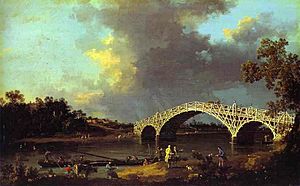William Etheridge facts for kids
William Etheridge (born around 1708 – died 3 October 1776) was a clever English engineer and architect. He was famous for designing several amazing wooden bridges. Many of his bridges used special mathematical ideas in their design.
Contents
Who Was William Etheridge?
William Etheridge was born in a small village called Fressingfield in Suffolk, England, around 1708. His parents were Charles Etheridge and Elizabeth Brett. His family had been carpenters in Fressingfield and Stradbroke for many years.
Etheridge's Early Career
From 1744 to 1749, William Etheridge helped build the Westminster Bridge in London. He started as a foreman, which is like a team leader. Later, he became the master carpenter, overseeing all the wood construction.
Famous Bridge Designs
Etheridge designed several important bridges:
- Around 1748, he designed the Old Walton Bridge.
- Before 1750, he designed the Old Bridge at Coleraine, Northern Ireland.
- In 1752, another engineer, George Semple, asked Etheridge for advice. This was for rebuilding the Essex Bridge in Dublin.
William Etheridge passed away on 3 October 1776 in Westminster.
The Amazing Old Walton Bridge

In 1747, a rich businessman named Samuel Dicker moved to a new estate near Walton-on-Thames, Surrey, England. He wanted an easier way to get to his new home. So, he asked the British Parliament for permission to build a bridge and charge people to cross it.
Building the Bridge
William Etheridge designed this wooden bridge, known as the Old Walton Bridge. Mr. White of Weybridge built it between 1748 and 1750. When it opened, its middle section was 130 feet long. This was the longest bridge span in Britain at the time!
People admired the bridge for its "strength" and "clever design." Some even called it "the most beautiful wooden arch in the world." Famous painters, like Canaletto, painted pictures of this bridge.
The Bridge's End
Samuel Dicker thought the bridge would last 200 years. However, by 1778, it was already falling apart. It was taken down and replaced with a new bridge made of brick and stone between 1783 and 1786.
The Mathematical Bridge
The Mathematical Bridge is a popular name for a wooden footbridge in Cambridge. It crosses the River Cam and connects two parts of Queens' College, Cambridge. William Etheridge designed this bridge, and James Essex built it in 1749. It's famous for its unique design that looks like it's made without any arches, even though it uses clever geometry.
Old Coleraine Bridge
Before 1750, Etheridge also designed the Old Bridge over the River Bann in Coleraine, Northern Ireland. This bridge was made of timber (wood) resting on stone supports. It replaced an older bridge that had been damaged in 1732.

